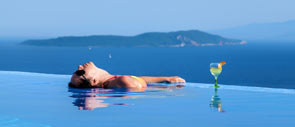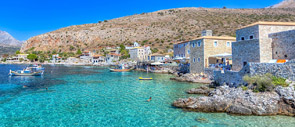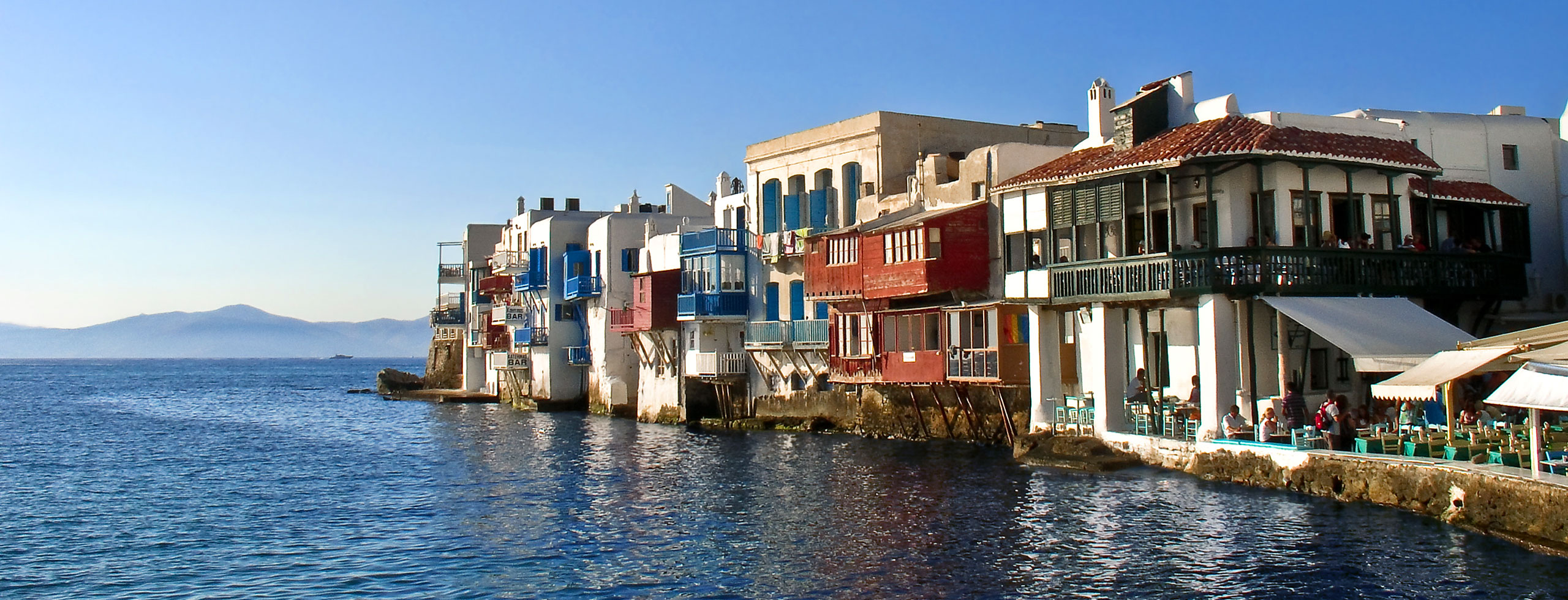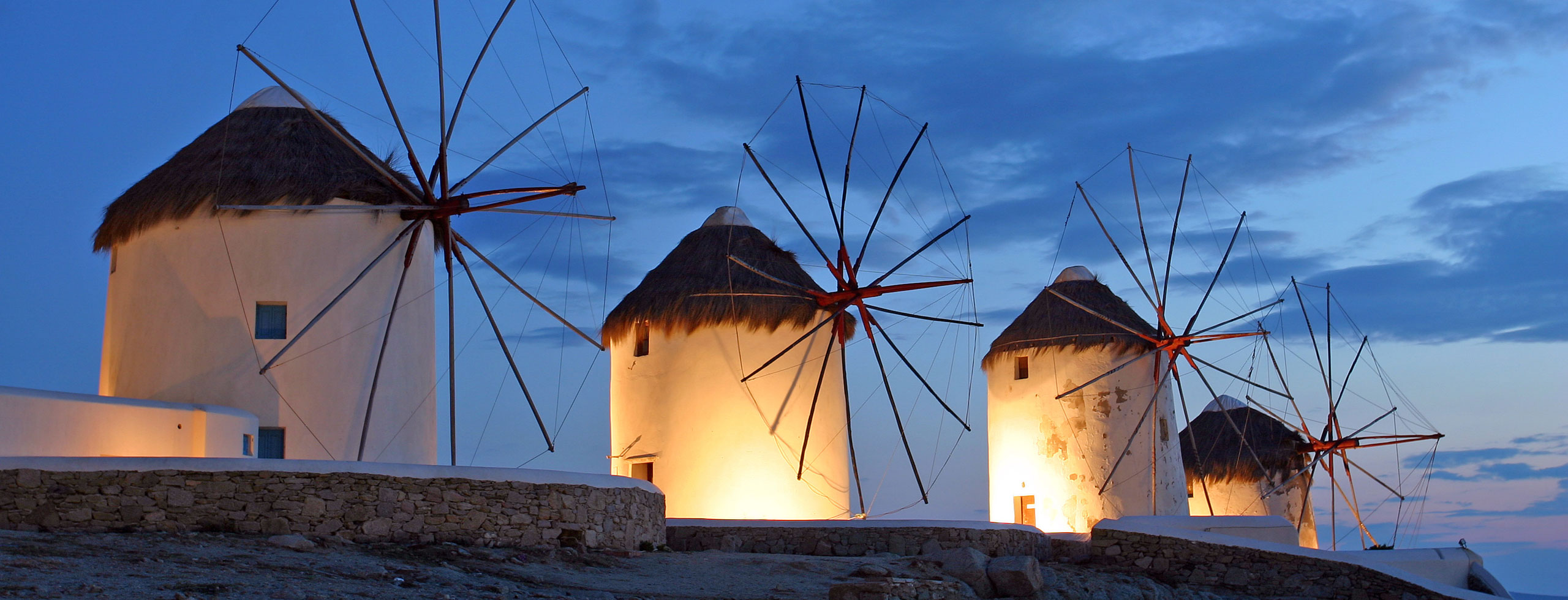Mykonos Island Greece - Travel information, Mykonos hotels, villas, tours, restaurants, beaches, archaeological sites, nightlife
In recent years Mykonos has become internationally famed for its beaches and nightlife, and there is no denying that in high season Mykonos "jumps". Mykonos Town rewards the curious with a captivating network of lanes and squares, houses and balconies, churches and museums, and is also the starting point for excursions to the uninhabited islet of Delos. Reputed to be the birthplace of Apollo and Artemis, Delos was the religious center of the Aegean world between at least 800 BC-AD100. Contemplating the extraordinary remains of ancient Delos rewards a once-in-a-lifetime excursion that complements the more contemporary attractions of Mykonos.
A Place to Relax, to Unwind, to Unbutton
Of all the Greek islands that have become favored destinations in recent years, none is more prominent than Mykonos. It might not have been predicted. Here is this small island, barely 30 square miles, with virtually no role in or remains from Greece’s ancient glories. It has no dramatic natural features—no mountains, no vistas, no exotic vegetation. It has no major architectural structures—except the neighboring Delos island—or cultural institutions. Yet each year Mykonos attracts hundreds of thousands of visitors, drawn there by its basic appeal: the ultimate holiday spot. A place to relax, to unbend, to unbutton. A place to enjoy life’s simple pleasures—a leisurely breakfast along the harbor, a day at the beach, a late afternoon’s drink at a café, a stroll through a town with its narrow streets and fine shops, an evening’s meal under the stars in a quietly elegant restaurant.
Leisure on Mykonos
Most people will be heading for the beaches and fortunately there are many choices. Two are conveniently close to Hora itself, but those on the south coast are most popular. Some on the south shore—Paradise, Super Paradise--are “party beaches,” which means music, drinking, or nudists. Other fine beaches on the Mykonos coast are Elia, Panormos, Psarou, Paranga, or Platis Gialos. Because the north coast gets more wind, the beaches there are less frequented; one—Ftelia—attracts windsurfers.
Back in Hora, the main activity is strolling around the maze of narrow streets and alleys-- and trying to find your way out! The legendary explanation for this maze happens to be true: as a weak and undefended island, Mykonos was constantly exposed to the pirates who roamed the Mediterranean, and the layout of the town was intended to frustrate and foil any who came ashore. Today’s visitors need not fear pirates but will find themselves tempted to spend their money on some of the fine jewelry, clothing, weavings, and artworks made or sold in the many small shops that line these streets. Mykonos is especially famous for vegetable-dyed hand-loomed textiles.
At the end of the day, figuratively and literally, most people will be looking forward to settling down in one of the many bars, cafes or restaurants now gracing not only Hora but several of the smaller villages and beaches of the island. They’re not cheap—but then the sunset is free! In Hora, too, the noise level in the evening can be quite high—we warned you, people come to Mykonos to unbend! Many of the most popular hangouts are around the harbor, where a centuries-old attraction are the pelicans that are at home here. Another favorite gathering area in Hora is the neighborhood known as Little Venice, south of the main harbor, with its balconies above the water and next to the oft-pictured windmills.
Mykonos Highlights:
- Rich nightlife
- Extraordinary Beaches
- Picturesque Scenery
Mykonos History
Although most people may not go here for the island’s historical associations, Mykonos does have historical interest as it was ruled during the Middle Ages by Italians before setting up as an independent community in 1615, and in the 1820s it took a leading role in Greece's uprising against the Turks. But the site of the most important historical value is the neighboring island of Delos, which had been a religious center for ancient Greeks at least since 1000 BC. By the year 700 BC it was the site of a famous festival in honor of Apollo and Artemis, and after the Athenians defeated the Persians in 480 BC they made Delos the center of the Athenian Confederacy, a maritime league that soon became little more than an Athenian empire.
Mykonos Through the Centuries
The island has been settled since at least 3000 BC but it played no major role in the pre-classical world, by which time it effectively became a colony of Athens. During the ensuing centuries, it went along with the powers-that-be, prospering under Alexander’s Hellenistic successors and the Romans, but declining under the Byzantine Greeks. It re-emerged on the stage of history after the Crusaders took Constantinople in 1204 and Mykonos was given to some Venetians. Mykonos remained under Italian rule until the Ottoman Turks took over in 1537; but although the Turks owned Mykonos until Greece gained its independence in 1829, the Italian presence remained strong. One of Greece’s most famous daughters, by the way, is Manto Mavrogenous, credited with rousing her fellow Mykonians to take up arms against the Turks in 1821. She is honored by a bust in the square named after her, located just up from the center of the harbor.
For the next 150 or so years Mykonos remained a relatively obscure island, although by the 1960s it was beginning to attract a small coterie of “insiders”—artists and crafts people, vacationing Athenians, and increasingly large numbers of gays and lesbians. Not until the 1970s did it begin to attract large numbers of tourists, eventually becoming a major stopover for cruise ships and travelers who spend leisurely times on the island. Today Mykonos prides itself on providing a diversity of accommodations and facilities to satisfy a wide spectrum of visitors.
Delos
But if Mykonos does not hold archaeological remains that require attention, it is the jumping-off point for one of the major archaeological sites of Greece –indeed, in the world: the island of Delos. Only some 3 miles by boat from Mykonos, this is a half-day excursion that virtually everyone who has made it to Mykonos is willing to make. Delos has been a religious center for ancient Greeks at least since 1000 BC, and their myths claimed it as the birthplace of Apollo and his sister Artemis. By the year 700 BC it was the site of a famous festival in honor of Apollo and Artemis, and after the Athenians defeated the Persians in 480 BC they made Delos the center of the Athenian Confederacy, a maritime league that soon became little more than an Athenian empire. Under the Athenians, the Delian Festival was held every four years, with religious ceremonies, athletic events, music, theater, and dance—exactly like the better-known Olympic Festival. Delos also had a famous oracle, much like that at Delphi.
It was after the death of Alexander in 323 BC, however, when the island fell under the control of the Greek Ptolemies based in Egypt, that Delos truly flourished, attracting offerings from throughout the eastern Mediterranean. For the next 350 or so years—first under Greeks, then under Romans-- Delos was favored with a succession of ambitious structures whose remains provide most of the attractions that amaze visitors today. During these centuries, Delos’s role in the eastern Mediterranean was far more than a religious sanctuary; it became a major maritime port and commercial center, drawing a large and international population. A visit to Delos is a once-in-a-lifetime event—and you will of course be rewarded on your return by the pleasures of Mykonos.
Route 1: The Beautiful Hora
The ancient Greeks always expected the small, barren island of Mykonos to be overshadowed by the sacred island of Delos, but in modern times, especially since the 1970’s, the scene changed and Mykonos became one of the most popular travel destinations in the Mediterranean. More than one million travelers come to Mykonos every year and they all love to take long walks in the narrow streets of Mykonos town, or otherwise called Hora. The once small village is the archetype of the Cycladic architecture – in fact the specific and special architectural characteristics that are evident all around Hora are protected by law. White cubic houses, colorful balconies, pots full of flowers, and open spaces: it is through this combination of white color and bright light from which you can view the beautiful blue sea of the Aegean. Mykonos town, of course, has become a rather cosmopolitan area: taking a relaxing walk through the streets, whether shopping or just window shopping, you are apt to bump into members of the international jet-set, top models, fashion designers, and Hollywood movie stars. Even though this colorful river of people floods into the streets, the small village retains its charms and alongside the modern shops and markets you can find traditional tavernas and old cafes, where you can taste the famous kopanisti cheese and listen to the old Mykonians in the typical black seaman’s hat talking with their special idiom.
Mykonos is full of chapels, and some of them are rare monuments of ecclesiastical architecture. In Hora, you should definitely visit the most famous (and most photographed) chapel, the holy symbol of Mykonos, Panagia Paraportiani. It is a graceful Byzantine church with an impressive bell tower and asymmetric volumes, a rare jewel of traditional Greek architecture. It might be of interest to know that Panagia Paraportiani means “Virgin Mary of the gate side”, named after its position next to the castle gate. Today you won’t see a castle but visiting that spot when the summer wind of the Aegean Sea blows strong –the famous “meltemi” – you will feel a touch of magic, especially if you are visiting at a time when the full moon is looking over you (you might want to have company for that experience!). Other important and beautiful Byzantine chapels in Hora are Agia Ypakoi and Agia Eleni tou Kastrou.
After hanging around Matogianni and Mitropoleos streets, filled with fashion designer and jewelry stores, don’t forget to see the windmills at the edge of the town: it’s no wonder that every visitor of Hora takes a picture here, since the view is truly breathtaking. But Hora’s most intriguing pleasure remains--enjoying the sunset at Alefkandra quarter, the famous Little Venice of Mykonos. This is one of the most charming areas of the town with some the best coffee bars on the island – and, of course, some of the most popular bars in all of Greece.
Route 2: The Famous Beaches Close to Hora
Don’t be fooled into believing that all the people who visit Mykonos every summer are attracted only by the cosmopolitan crowds and the exciting night life the island has to offer. Summer in the Aegean means sea and sun, and the beaches of Mykonos are some of the best places in the Mediterranean for that. Those spectacular beaches, most of them with their seaside cafes, sun-beds, and bars, are one of the main reasons that Mykonos has become so popular. The most famous, cosmopolitan beaches are to be found at the southern part of the island, where they are protected from the strong summer wind – the meltemi. From the long, sandy beach of Ornos, decorated with old fishing boats, to the world renowned and beautiful beaches of Psarou, Paranga, Platis Gialos, Elia, Paradise (known also as Kalamopodi beach) and Super Paradise beach, you are certainly going to find the beach that looks right for you. They all have crystal clear waters with green turquoise colors, are equipped with excellent beach facilities, and most offer a variety of water sports. Cavo Paradiso on Paradise Beach keeps the party going all day and all night long, whereas Super Paradise is known as the famous gay beach, popular among homosexuals from all around the world. The cosmopolitan Psarou beach remains the hottest “trendy” scene on the island, while Kalo Livadi and Panormos provide fabulous alternative options that are typically frequented by the rich and famous visitors of the island.
Aside the cosmopolitan beaches, two beaches worth a visit are Agios Ioannis and Kapari beach, close to Agios Ioannis, behind the small chapel. In all beaches of Mykonos, apart from swimming, reading a book, sunbathing or just relaxing at the beach, you will be sure to meet interesting, cheerful people all around you; it is up to you if you want to join them in an endless party. But even the short trip to those beaches is truly enjoyable, since you will be driving through the beautiful grey-green hills of Mykonos, interspersed with many bright, white-washed chapels with dome-shaped roof tops and impressive bell towers (there are over 350 chapels all over Mykonos!). If you do not have a rental car for your stay, you may use taxi cabs or public transportation to visit various parts of the island. When you reach Psarou and Platis Gialos, take a look at some interesting ruins of ancient towers built during the Hellenistic period (locals call the location Portes – “doors”). To the north of Hora you will reach the settlements of Tourlos and Agios Stefanos, where you will catch sight of ultra-elegant villas and mansions; in fact, you are apt to encounter these in almost any area of Mykonos - a villa in Mykonos is the ultimate goal of the modern, well-off Greek businessmen. You can swim in the small sandy beach of Agios Stefanos, but if you prefer a larger beach, you may visit Houlakia bay by following the road to the light house on the Armenistis cape.
Panormos and Marathi are small villages north of Hora. Near Marathi you will see a serene, artificial lake with an interesting Byzantine chapel nearby, named Panagia Koumarou. Very close to Panormos, there are two sandy beaches, Panormos (particularly popular for Greeks) and Agios Sostis, where you can swim only when the northern winds are not as strong. With the same weather conditions you can also swim at the vast sandy beach of Ftelia. Since it is often quite windy at Ftelia, especially in August, you can explore the ruins of a Neolithic settlement located beside the beach instead of swimming at Ftelia. If you have access to a boat and are experiencing good weather, you can also explore the small sandy beaches between the Armenistis and Limbounia Capes.
Route 3: Excursion to Delos
During ancient times, according to Greek mythology, Delos was a moving island, freely roaming in the sea. Today it is quite stable and you can visit it easily with a hired boat from Mykonos or by joining in on a scheduled excursion. (Boats depart daily, except on Mondays, when Delos is closed to the public.) Delos is truly a place not to be missed, if only to enjoy a truly delightful walk among the ruins of one of the most important and sacred cities of the ancient world. The island where Leto gave birth to Apollo, god of the sun and music, and Artemis, goddess of the moon and the hunt, Delos is not only important from a mythological perspective but also a fascinating archaeological site, with the ancient statues, pillars, temples, and ruins matching perfectly with the nature of the isolated, mountainous, and treeless Cycladic Island, home now to only a few shepherds (and uncountable lizards)! The archaeological site is divided in four groups of monuments: the area close to the big temple of Apollo, the Quarter of the Lake, the Quarter of the Theater, and the area of mount Kynthos. At Delos you will also see what is left from the three temples of Apollo, and the arches and buildings with offerings from the ancient inhabitants of Paros and Naxos. Take a walk around the granite palestrae (the boxing rings), the Odeon, the theater, the temples, see the forums and the prytaneia (the senior magistrates building), and of course visit the lake where Apollo and Artemis were born. You may well have already seen photographs of the best-known remains of Delos--a road lined with statues of marble lions: as you walk this famous Street of Lions and experience it for yourself, it is as impressive and magical as the photos make it appear. While on Delos, too, you should take at least a short visit to the Archaeological Museum, with its collection of fine classical and archaic sculptures, Roman and Hellenistic statues, ceramics, jewels, the mosaics and the wonderful statue of Apollo. After a truly memorable few hours at Delos, Mykonos awaits you for exploring further.
Route 4: The Less-known Eastern Mykonos
For a more isolated and not frequently visited side of Mykonos, we strongly recommend visiting the village of Ano Mera. The landscape of Mykonos here is really beautiful: small green fields, whitewashed houses, picturesque windmills, and small chapels with red roof tops, all bathed in the hot summer light and surrounded with carpets of wild flowers, granite rocks, and the blue sea. You can also find some fine beaches north of Ano Mera. These are the beaches of Kalo Livadi, the small picturesque beach of Agia Anna, and the famous Kalafati beach, decorated with “almyrikia” trees. East of Ano Mera is the little-known part of Mykonos. It may seem strange but on an island that is flooded with tourists every summer, there are still some small bays with unknown idyllic beaches, decorated with a sole white chapel. Mykonos is never been known to attract explorers and that is the reason few visitors are acquainted with the beautiful beaches of Fokios and Mersini, which are located to the north of Ano Mera. There are beaches on the eastern coast of Mykonos that can be truly described as hidden jewels, all located around Profitis Ilias Anomeritis Mountain (where you can also see the old mines of the island). They are the beaches of Pano and Kato Tigani, of Vathia Langada, of Frangia, of Tsangari and of Lia.
Museums & Activities
- Archaeological Museum, Hora: Visit this gem of a small museum and admire forms and decorations in a complete collection of ingeniously restored pottery and artifacts that present the history of the island.
- Folklore Museum, Hora: This museum showcases the interior decoration of the traditional white-washed houses of Mykonos. Its rich collection of beautiful, everyday household objects spans hundreds of years, and ranges from medieval times to the twentieth century.
- Marine Museum, Hora: This Naval Museum will take you on a journey into the past, inspired by the memorabilia from the island’s naval history and tradition, and will enhance your understanding of everyday life at sea through the centuries.
Other Notable Sites:
- The Panagia Paraportiani Church, Hora: A symbol of Cycladic architecture, the beautiful Panagia Paraportiani church is a remnant of the medieval town of Mykonos, and consists of five chapels elegantly put together in a unique combination.
- The Roman Catholic Church, Hora: A papal gift to the once one and only family of Christian Catholic faith on the island, this beautiful and sole Catholic chapel in Mykonos is dedicated to Our Lady of the Angels.
- The Tourliani Monastery, Ano Mera: Built in Cycladic style, this beautiful medieval Monastery includes the biggest Byzantine church on the island, with wonderful arched cloisters around it, and boasts a collection of old ikons and exquisite carved-wood decorations.
- The Windmills: Arguably the most recognizable of the island’s landmarks, the traditional windmills captured the energy of the wind with their canvas sails and made flour from the island's grains. Today, one is still operational, but many more please the eye of every Mykonos visitor.








 View Mykonos Map
View Mykonos Map 